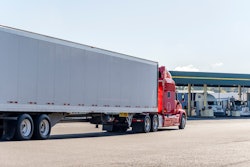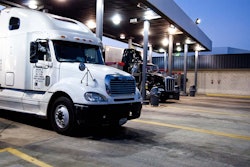Diesel prices have been on a rollercoaster ride in recent years, with prices soaring in 2022 and slowly falling to a more palatable national average of late. After diesel averaged $4.21 a gallon across the U.S. through 2023, prices have continued to moderate down to a roughly $3.70/gal national average as of March 2025.
You can make the wisest business decisions about fuel when you know your fuel economy, expressed in miles per gallon, and your fuel cost per mile (CPM).
Calculate your mpg simply by tracking your mileage between fill-ups and dividing the total by the number of gallons you burned. Do this for all trips. Fuel economy constantly changes, affected by weather, loads, routes, traffic, terrain, road surfaces and other factors. It’s helpful to know mpg per month, per week and even per load. That occasional haul of steel across the Appalachians may be costing you more in fuel than it’s worth. If your numbers look bad, don’t give up; the worse your fuel economy, the more you have to gain by improving it.
Armed with your mpg, calculating your CPM is easy. Suppose your truck gets 6 mpg, and you ran 6,000 miles in a month, meaning you burned 1,000 gallons (6,000 divided by 6). If diesel averaged $4 per gallon that month, your total cost was 1,000 x $4, or $4,000. Your fuel CPM was $4,000 divided by 6,000, or 67 cents -- likely the largest single chunk of your total CPM. It will pay you huge dividends to consider strategies for cutting your fuel bill.

For good fuel economy, your truck has to overcome three things: rolling resistance, air resistance and gravity. Fortunately, your driving technique and other choices you make can address each of these.
[Related: In a tough trucking-business environment, owner-operators must improve efficiency to compete]
Reduce your average speed
Owner-operators get no shortage of “encouragement” from shippers, consignees and others to hurry, so it’s easy to get into the trap of driving fast. But speed is the main reason for increased fuel consumption and reduced profit. Experts agree that every mile per hour driven over 60 mph reduces fuel economy by one-tenth of a mile per gallon.
The typical argument against driving slower is that you can make better time by driving faster and therefore make more money. But compare one driver running at 70 mph getting 5.5 mpg and another running at 60 mph getting 6.5 mpg. Driver A is 10 miles farther down the road than driver B after an hour, but at $4 per gallon, he’s spent $13.99 more to go those 10 miles in the same amount of time.
That might not seem like much money, but the impact over an entire year is stark. If you drive 130,000 miles per year and average 5.5 mpg vs. 6.5 mpg because you drive faster, you will spend $14,545 more on fuel.
Most owner-operators net about 60-70 cents per mile. If you divide the extra $14,545 fuel expense that driving faster costs by a net per mile of 60 cents, you would have to drive 24,242 miles more per year just to pay for the extra fuel.
Limit idle time
Idling requires about a gallon of fuel per hour, which can cost you about $160 per week at $4 per gallon if your truck idles eight hours a day.
According to the U.S. Environmental Protection Agency, line-haul trucks not equipped with auxiliary power units (APUs) might idle about 20% to 40% of the time the engine is running to power climate-control devices and sleeper compartment accessories and to prevent startup problems in cold weather.
Just because idling is common doesn’t make it smart. Idling easily can cost you a few thousand more in fuel alone per year, not including the added engine maintenance expense that results from excessive idling, harder on your truck’s engine than highway driving. In addition to operating costs, many governments impose no-idling laws with fines as high as $25,000.
Instead, there are many alternatives. An extra blanket for cold temperatures and window screens for when the weather is warm make it easier to turn off the engine. For very little expense, you can buy a remote starter with a temperature sensor that will start the truck at a specified temperature.
APUs can pay for themselves in a reasonable amount of time. A mobile generator costing as little as $200 will burn less fuel and provide heating and cooling.
Choosing idle-reduction technology. This can be a difficult decision. Systems and costs vary widely. Diesel-fired heaters are near the bottom of the cost range for purchase and annual maintenance (about $1,000 with purchase and a year’s worth of maintenance). Full-function diesel APUs/gensets are at the top, up to $8,000 or more, and battery-powered systems have become common at similar or lesser price points.
Evaluate your idle-reduction needs by keeping a detailed idle log. Write down every time you idle and why. Keep track of hours idled, and sort them by reason, such as air-conditioning, heat, AC power, warming the engine, etc. Try this for a year, accounting for all seasons. That may not be practical, but if you keep this log for three months and are disciplined in your records, you will be able to make good estimates for the other seasons.
Idling solutions have pros and cons, and most revolve around the reason for idling; if you idle only because you need heat, then a full-blown APU is overkill. A better solution is a small diesel-fired heater -- easy and inexpensive to use.
If you idle to produce AC power for a computer, TV, coffee maker, microwave, etc., you also can find inexpensive alternatives to a diesel-powered APU. Inverters and high-capacity battery systems will keep small appliances running for days. Add a small solar panel, and you can keep the batteries conditioned and extend that time as well, perhaps using electrified parking installations if you need to park for an extended period.
Once you have a clear understanding of how often you idle and why, research the options in today’s market. Then calculate the break-even point and return on investment for each solution.
[Related: Solar power can reduce idling, protect batteries]
Use new-truck tech to your advantage
If you’re driving with an advanced driver-assist system like those present in many newer trucks today, there are ways to blend old-school ways with those new-school tools to help save on fuel.
Don’t think about driving with an advanced assist system as old-school v. new technology. It is old-school enhanced by technology. Merging old-school ways with new-school tools maximizes both safety and efficiency -- that’s key for profitability.
[Related: Keen fixed, variable cost understanding key to owner-operator success]
As you always have, watch what is going on ahead of you in order to keep your momentum. Losing momentum means you have to get back up to speed, which uses more fuel.
Increase your following distance by seven seconds to give yourself time to adjust your speed to a situation and allow the truck to slow itself down. This gives you more time to move over, often without hitting the brakes, and helps you react before the vehicle does it automatically.
Think ahead of your safety system. The typical collision-mitigation system, with automatic braking, reacts when you are within 3.6 seconds of the vehicle ahead. Most interactions with the collision mitigation systems are minor braking events.
Learn to coast into reduced-speed zones and curves. The less you use your brakes, the less fuel you use. Brake if you need to, but try not to put yourself in the position where you need to, unless you’re stopping.
Incentive to improve fuel economy: What's an extra mpg worth at today's rates?
Increasing efficiency is a multifaceted project, as small fleet owner-operator Alec Costerus so deftly detailed in 2024 right here in Overdrive.
[Related: In a tough trucking-business environment, owner-operators must improve efficiency to compete]
There's a lot that can be done, but what turns the most heads about the 2024 Trucker of the Year semi-finalist Costerus' prescription for better efficiency is the 10-mpg-plus fuel mileage he and Joel Morrow and their Alpha Drivers Transportation business squeezed out of Class 8 equipment through a combination of spec'ing, modification, behind-the-wheel technique, training and operational considerations.
As detailed in this piece of the Partners in Business playbook, increasing fuel efficiency sits squarely within the realm of possibility for every owner-operator. What's it worth at today's rates? Computing an average fixed-cost-per-day-worked figure utilizing figures from Overdrive's Partners in Business coproducer ATBS's mid-year 2024 presentation (with a conservative 220 days worked annually), fixed cost per day comes out to $256. (Your own fixed costs may be higher or lower -- the ATBS figure includes the broad average of all clients, including both leased and independent owners.)
The average owner-operator spent around 73 cents/mile, then, on variable costs on the whole, according that same mid-2024 computation, the large majority of that (57 cents/mile) on fuel. ATBS clients averaged as of mid-year 2024 right around seven mpg for fuel mileage. What might a gain of just a single mile per gallon to eight mpg for that average owner-operator be worth? The most basic answer is about seven cents/mile, to get fuel spend down to just a couple quarters/mile.
What does that look like in terms of a profit boost? Drop all those costs into Overdrive's Load Profit Analyzer tool you can make the following comparison -- for a single load moved from Dallas to Chicago (~950 miles) at the February national average spot rate of $2.31/mile, skipping the Analyzer's salary cost input field to focus solely on the impact of reduced variable costs with fuel-mileage gains.
This approximate two-day run, being conservative and allowing plenty time spent loading and unloading, would net the eight-mpg owner an extra $66, or $33 daily. It doesn't seem like much on a day-to-day basis, but multiply that by by 220 days under load in an entire year and the potential is huge over the long term. (Would you turn down an extra $7,260 annually if someone offered it?)
[Related: Trucking in the freight trough: The 'sweetness of low price' v. 'the sour of bad service']
A single mile-per-gallon boost in efficiency is achievable in various ways -- February 2025 Trucker of the Month Kenny Wingate added a "whale tail" fairing to his mid-roof 2020 Pete 579, pulling a reefer, to increase aerodynamics and almost got there, netting 0.7 mpg for his own average with just that addition. Installed himself, it began to produce real returns in just a few months.
What would an increase to the admittedly sometimes magical-seeming 10 mpg be worth? You'd save a whopping 30 percent on fuel spend -- for that average ATBS client just more than 17 cents per mile.
The extra approximate $80/day net x 220 days under load annually would add $17,600 on the bottom line. Real difference-making income. Getting there overnight isn't an easily achievable task, but with the right combination of practices you can improve mightily.
Alpha Drivers Transportation's Joel Morrow, past Overdrive Trucker of the Year Henry Albert, and others presented at the Mid-America Trucking Show in 2023 with a bevy of ideas for improving efficiency in the context of how they themselves hit and passed the 10 mpg mark. Listen in on that talk via the 2023 edition of the Overdrive Radio podcast embedded below.
Read next: More smart practices: Controlling fuel costs, improving efficiency, understanding fuel surcharges












